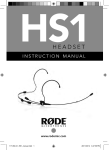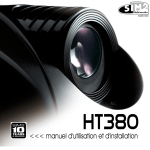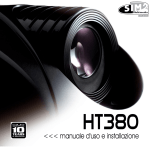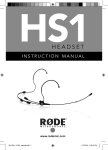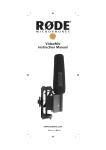Download USER GUIDE
Transcript
ALP5 BIAMPLIFIED DIRECT FIELD MONITOR SYSTEM USER GUIDE Thank you for choosing the Active Linear Phase™ Biamplified Direct Field Monitor System. To get the most from your new monitors, please take a moment to read this manual and familiarize yourself with the product’s features, set-up, and use. About the Active Linear Phase Monitor System Our engineers have spent years designing transducers, studio electronics, and high performance studio monitoring systems—including some of the most popular professional speakers used today. Now, using the latest digital acoustic design tools and high performance driver and power amplifier technology, they’ve developed the Active Linear Phase 5, the new standard for performance and value in biamplified direct field monitors. The Active Linear Phase 5 features the time-proven mineral-impregnated 5.25” low frequency driver that’s been at the heart of “small footprint” Event monitor systems from the start, including the Tria™, the Project Studio 5™, and most recently, the Tuned Reference 5™. The unit’s high frequency driver is a direct descendant of the one used in the critically acclaimed Studio Precision series. But the real magic comes in the sonic combination of these two custom-designed components, courtesy of the ALP5 front panel baffle. The seemingly simply baffle is actually a rather cleverly engineered design that creates an elliptical wave guide for the high frequency driver while at the same time aligning the phase and time relationships of the low and high frequency driver components. The result is a monitor that provides significantly greater imaging accuracy and a wider sweet spot than those using traditional designs. Unpacking The shipping container and inner box are designed to protect your speakers during transit. Please unpack and check your speakers carefully, and immediately report any damage to your dealer or to the company that delivered the speakers to you. The packing materials are designed to be reused—do not discard them. If you need to return the speakers to the factory for repair, they must be shipped in the original packaging. Setup You’ll notice that the Active Linear Phase monitors are physically identical. When used in a stereo configuration, there is no physical or acoustic distinction between the left and right speakers. Note, too, that the cabinets can sit vertically or horizontally without regard for performance, so long as both cabinets are situated in the same direction. When placing them in a horizontal position, orient the cabinets with the high frequency drivers pointing to the outside, away from each other. Since each cabinet’s bass port is front-mounted, you can position the monitors near a wall (or even in a wall) without fear of blocking the port, which would compromise the bass response. Your monitors should be placed on a stable surface at about ear level. A typical location would be slightly behind and to either side of a small console. The distance between the monitors should equal the distance from the listener to either speaker. This is the common “equal length triangle” rule for speaker placement shown in Figure 1. Figure 1. When the listener and the monitors are positioned in an equal triangle with the monitors directly facing the listener, the listener is situated in the “sweet spot,” which yields optimum stereo reproduction. Notice that Figure 1 also shows the speaker cabinets turned slightly inward, so that the driver components directly face the listening position. When oriented this way, the listener is in the “sweet spot,” which yields the most accurate stereo reproduction. When the speakers are properly rotated toward you, the ALP5’s power indicator LED will be clearly visible, with no part of it blocked by the front panel baffle. If you must mount the speakers substantially above or below ear level, you will also need to tilt the cabinets downward or upward to keep the driver components directly facing you. Again, use the LED as an indicator of proper positioning. As you become more familiar with your speakers, you may find it helpful to move around in the soundfield to locate the optimum listening position for your particular monitoring environment. But if you follow the equal distance, ear-level, face-on rules outlined above, you’ve already optimized their position for a single user in most situations. Connections and Operation Please refer to Figure 2 on the opposite page. Balanced XLR Line Input This jack accepts a male XLR connector, wired for either balanced or unbalanced operation. For balanced operation, please consult the pin wiring diagram on Page 5 or on the monitor’s back panel. The Line 1 input is hardwired in parallel with the Line 2 input, so either may be used as an input or as a pass-through connection. Input specifications apply to both inputs equally. Balanced 1/4” Line Input This jack accepts a male two-conductor 1/4” TS or threeconductor 1/4” TRS connector, wired for either balanced or unbalanced operation. For unbalanced operation with a TS connector, the minus signal is automatically grounded; with a TRS connector you have the option of leaving the minus input open or grounded. We recommend, however, that you ground the minus input. For balanced operation, which requires using a TRS connector, please consult the pin wiring diagram on Page 5 or on the monitor’s back panel. The Line 2 input connector is hardwired in parallel with the Line 1 input connector, so either may be used as an input or as a pass-through connection. Input specifications apply equally to both inputs. Unbalanced RCA Line Input This jack accepts a male RCA connector, wired for unbalanced operation. This jack is hardwired in parallel with the balanced line inputs. However, due to it being an unbalanced input, we do not recommended using it in combination with either of the balanced inputs, as this will unbalance those inputs, possibly causing degradation of the audio signal. Voltage Selector. The correct voltage will have already been set for your region so there is no reason to touch this selector. Only authorized Event technicians are permitted to change the voltage. Please note that any evidence of tampering with the voltage selector will invalidate the products warranty. On/Standby INPUT SENSITIVITY -5dB Input Sensitivity -20dB MAX Balanced XLR Line Input BALANCED INPUTS Balanced 1/4” TRS Line Input Tip - single (-) Ring - single (+) Sleeve - ground Pin 3 (+) UNBALANCED INPUT Pin 2 (-) Pin 1 (ground) Unbalanced RCA Line Input ALP5 BIAMPLIFIED DIRECT F I E L D M O N I TO R S Y S T E M WWW.EVENT1.COM CAUTION VORSICHT BEFORE OPENING PULL MAIN PLUG VOR DEM OFFNEN NETZSTECKER ZIEHEN AVERTISSEMENT POUR PREVENIR LES RISQUES D’INCENDE OU DE CHOC ELECTRIQUE, EVITER D’EXPOSER CET APPAREIL A LA Voltage Selector WARRANTY VOID IF REMOVED FUSE INSIDE INLET T4AL 250V WARNING: TO REDUCE THE RISK OF FIRE OR ELECTRIC SHOCK, DO NOT EXPOSE THIS APPLIANCE TO RAIN OR MOISTURE. Power Connector ■ 100V ~ ■ 120V ~ ■ 220V ~ ■ 240V ~ 50/60Hz 60Hz 50Hz 50/60Hz 40VA 40VA 40VA 40VA Figure 2. Active Linear Phase rear panel connections and controls. Input Sensitivity This control is used to compensate for different signal levels that appear at the input. The control has a 20dB range; when set at maximum (MAX), 0.5V RMS input at the balanced in or 0.25V RMS at the unbalanced in will produce full amplifier output. Note that when the signal appearing at the input is too hot, the amplifiers may overload, causing distortion. If this occurs, attenuate (decrease) the Input Sensitivity by turning the control counter-clockwise. Standby Switch Push to turn the amplifiers ON; push again to activate standby mode. When the amplifiers are ON, the green LED located on the front of the monitor will illuminate. Note: In standby mode the mains power is still on. Power Connector This connector accepts the detachable AC line cord. Use the line cord supplied with your monitor, and make sure it is fully seated into the Power Inlet connector. For safety reasons, do not attempt to defeat the line cord’s ground connection. The power connector also houses the mains fuse which is replaceable by the user. Care and Maintenance Your Active Linear Phase monitors are simple to care for and maintain. The cabinets are finished with a durable vinyl laminate that can be cleaned with a soft damp cloth. Avoid touching the exposed speaker elements. Do not expose the rear panel controls, connectors, or the speaker elements to moisture or chemicals. Do not expose the unit to dripping or splashing liquids; objects filled with liquids should not be placed on the unit. Mix at reasonable levels to protect your speakers and your hearing. Contacting Customer Service If you experience any trouble with your Active Linear Phase monitors, please call the Event Electronics Customer Service department. Before calling, however, we ask that you please consult the Technical Support section of our Web site, www.event1.com. If you believe your Active Linear monitor is in need of repair, please contact the Event Electronics Customer Service department to request a Return Authorization Number (RA#). We can accept for servicing only those units that are accompanied by an RA#. Units shipped without an RA# number will be refused. Active Linear Phase Specifications Low Frequency Driver 5.25” magnetically shielded mineral-filled polypropylene cone with high temperature voice coil and damped rubber surround. High Frequency Driver 1” magnetically shielded natural soft dome neodymium with ferrofluid-cooled voice coil. Frequency Response 45Hz – 39kHz; 53Hz – 19kHz, ±3dB, Ref 500Hz. Crossover 2.6kHz active second-order asymmetrical Studio Precision Specifications (cont.) Sound Pressure Level (Output) >105dB Noise >100dB below full output, 20kHz bandwidth, unweighted Input Connectors XLR and 1/4” connectors; accept balanced or unbalanced sources RCA connector; accepts unbalanced sources Polarity Positive signal at + input produces outward low frequency cone displacement Input Impedance 40kΩ balanced, 20kΩ unbalanced Input Sensitivity 0.5V RMS input at the balanced ins or 0.25V RMS input at the unbalanced in produces full output with Input Sensitivity control at maximum. Input Sensitivity control range 20dB Protection RF interference, output current limiting, over temperature, turn-on/off transient, subsonic filter, internal mains fuse. Indicators Power ON LED indicator. Power Requirements 40VA, factory programmed for either 100V~ 50-60Hz, 120V~ 60Hz, 220~ 50Hz, 240V~ 50Hz mains. Cabinet 5/8” vinyl-laminated MDF, internally insulated. Dimensions 7.5” W x 10.5” H x 9” D Weight 11.95 lds each. Specifications subject to change without notice. International: RØDE Microphones. 107 Carnarvon Street Silverwater NSW 2128 Australia Ph: 61 2 9648 5855 Fax:61 2 9648 2455 United States of America: ©2003 Event Electronics, LLC P.O. Box 4189 Santa Barbara, CA 93140-4189 Ph: 805 566 7777 Fax:805 566 0071 Technical Support: For information and technical support questions. In the United States and Puerto Rico, contact: [email protected] Ph: 805 566 7777 In Australia, contact: [email protected] Ph: (02) 9648 5855 Anywhere except USA and Puerto Rico, contact: [email protected] Ph. Australia:+61 2 9648 5855 www.event1.com Event Electronics® is a registered trademark of Event Electronics, LLC. Studio Precision is a trademark of Event Electronics, LLC. Rode Microphones is a division of Freedman Electronics Pty Ltd.








